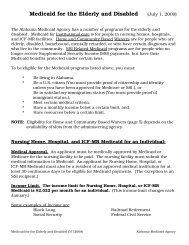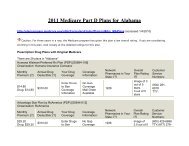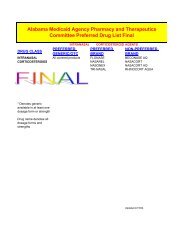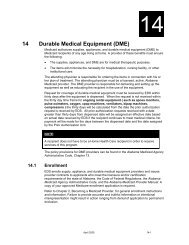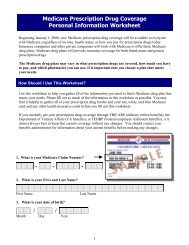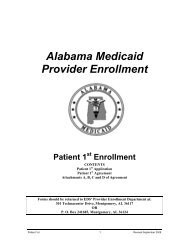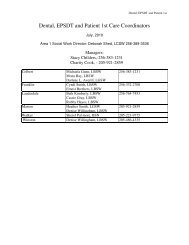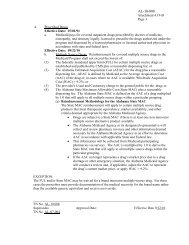PHARMACOTHERAPY REVIEW CNS STIMULANTS for treatment of ...
PHARMACOTHERAPY REVIEW CNS STIMULANTS for treatment of ...
PHARMACOTHERAPY REVIEW CNS STIMULANTS for treatment of ...
You also want an ePaper? Increase the reach of your titles
YUMPU automatically turns print PDFs into web optimized ePapers that Google loves.
III.TREATMENT GUIDELINESClinical trials demonstrating cardiovascular risk reduction with lowered serum lipids led to the release<strong>of</strong> a new set <strong>of</strong> national cholesterol <strong>treatment</strong> guidelines in 2001. 3-18 In these new guidelines, theNational Cholesterol Education Program (NCEP) – Adult Treatment Panel (ATP) III Guidelines, therole <strong>of</strong> LDL as the major atherogenic lipid component remained the primary focus, but non-HDLgoals, as well as LDL goals, are addressed by NCEP – ATP III. 19NCEP-ATP III guidelines define an LDL below 100 mg/dL as optimal. An LDL below 100 mg/dL isthe recommended goal <strong>for</strong> those who have experienced a CHD event (i.e., myocardial infarctionstable and unstable angina, revascularization procedure). The NCEP-ATP III guidelines went furtherto define a primary prevention population who have not yet experienced a CHD event and define thiscategory as CHD risk equivalent (see Table I). This population (CHD risk equivalents) has the sameaggressive LDL-lowering goal as those with diagnosed CHD. CHD risk equivalents include patientswith noncoronary atherosclerosis (symptomatic carotid artery disease, abdominal aortic aneurysm,peripheral arterial disease), diabetes and an ATP III Framingham-based CHD 10-year risk estimate >20%.Additional CHD <strong>treatment</strong> decision points and LDL goals, based on risk, are presented in Table 1.Table 1. CHD Risk Status, LDL Goal and Treatment Decision Points 19Risk StatusLDL GoalLevel to Begin LifestyleChange TherapiesLevel to ConsiderDrug TherapyCHD + CHD risk equivalents a < 100 mg/dL > 100 mg dL > 100 mg/dL b> 2 CHD risk factors c10-20% 10-yr risk < 130 mg/dL > 130 mg/dL > 130 mg/dL< 10% 10-yr risk < 130 mg/dL > 130 mg/dL > 160 mg/dL< 2 CHD risk factors c < 160 mg/dL > 160 mg/dL > 190 mg/dLabcRisk equivalents are noncoronary atherosclerosis, diabetes, greater than 20% 10-year CHD risk.If the LDL level is above 130 mg/dL, drugs may be started simultaneously with diet therapy. If the level is100-130 mg/dL, drug therapy may be considered, especially if lifestyle changes do not achieve the goal.Risk factors are man over 45 years <strong>of</strong> age, woman over 55 years <strong>of</strong> age, family history <strong>of</strong> premature CHD, highblood pressure, HDL below 40 mg/dL, current cigarette smoking.LDL-lowering strategies reduce CHD risk and CHD events by about 30% in 5 years (and perhapsmore with longer courses <strong>of</strong> therapy). The remaining 70% <strong>of</strong> patients still experience a CHD event.The need <strong>for</strong> further risk reduction is obvious.A high triglyceride level may be a risk factor one can target as evidence indicates elevations intriglyceride levels, as well as LDL levels, amplify CHD risk. 20-21 An elevated triglyceride levelprobably does not contribute to atherogenesis per se, but probably does signal the presence <strong>of</strong> avariety <strong>of</strong> lipid abnormalities (e.g., ↑ VLDL, IDL, ↓ HDL, ↑ levels <strong>of</strong> small, dense LDL). Patientswith high triglyceride (and LDL-cholesterol) levels <strong>of</strong>ten have several other CHD risk factors (e.g.,central obesity, impaired glucose tolerance, hypertension). This complex set <strong>of</strong> findings has beenknown as syndrome X, Reavan’s syndrome, dysmetabolic syndrome and most recently as metabolicsyndrome by NCEP-ATP III.2




